memory lane
This page is
specially built in fond memories of the animals that once contributed to the
very magic of Night Safari with their presence. For the newbie VRs, you may not
be aware that some of the following animals once inhabited Night Safari but are
no longer where they used to be because of the various reasons stated below.
Hence, this page hopes to provide a summarised insight into the past and recent
animal news and events in Night Safari. For the animals that were once found
along the tram route, they might only be familiar to VRs who are tram guides or
to VRs who take tram rides often. However, most senior VRs would have some
recollection of certain trail animals that have now been retired like TY
Beanies.
Change
From
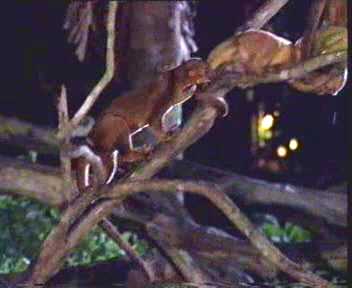 Kinkajou
- These seldom seen
little animals were finally retired since there was not much difference in
displaying them. They had a prime location outside the entrance of Night Safari
where there was no nearby competition from other animals for the attention of
the guests. But the kinkajous did not make full use of the opportunity given to
them so out they went. Heard that the group used to consist of a family and
young. Later it became a male and female pair who would often be seen mating in
public! What an amorous couple, LOL !
Kinkajou
- These seldom seen
little animals were finally retired since there was not much difference in
displaying them. They had a prime location outside the entrance of Night Safari
where there was no nearby competition from other animals for the attention of
the guests. But the kinkajous did not make full use of the opportunity given to
them so out they went. Heard that the group used to consist of a family and
young. Later it became a male and female pair who would often be seen mating in
public! What an amorous couple, LOL !
To
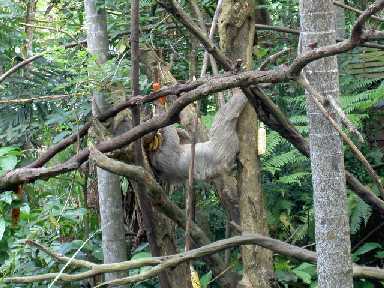 Hoffman's
Two-toed Sloth - With the
departure of the kinkajous, of all living things, Night Safari replaced them
with 3 equally hard-to-see animals - a mother 2-toed sloth with her young (?
months old) and a juvenile male (early 2003). The full-time Rangers are trying to condition
them to come out by hanging fruit, carrots and maize on the branches in front,
looking so much like a kampong farmer's backyard ! But in time to come, the
Rangers will place the food in more discreet locations so as not to make the
habitat look so unnatural.
Hoffman's
Two-toed Sloth - With the
departure of the kinkajous, of all living things, Night Safari replaced them
with 3 equally hard-to-see animals - a mother 2-toed sloth with her young (?
months old) and a juvenile male (early 2003). The full-time Rangers are trying to condition
them to come out by hanging fruit, carrots and maize on the branches in front,
looking so much like a kampong farmer's backyard ! But in time to come, the
Rangers will place the food in more discreet locations so as not to make the
habitat look so unnatural.
Latest news
dated May 2005-
The Kinkajous made a short come back to this entrance habitat in 2004 but by Mar
2005, both the Sloths and Kinkajous had to make way for the new Animal
Photography stage, as part of the series of phases in transforming the NS
entrance. Refurbishments are expected to be completed by Nov 2005.
From
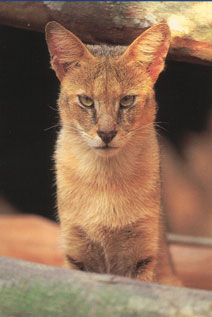 Jungle
Cat - Many
people say
that look just like the stray cats on the streets, just slightly larger. Nothing
is spectacular about the sand-colored Jungle Cats simply because they lack the
beautiful spotted or striped fur coats of their other wild cat cousins. But this
lack of beauty saved the Jungle Cat from poachers as they are not attractive
targets. However, they do make a nuisance of themselves by raiding poultry
farms, so farmers often set traps and poison for them.
Jungle
Cat - Many
people say
that look just like the stray cats on the streets, just slightly larger. Nothing
is spectacular about the sand-colored Jungle Cats simply because they lack the
beautiful spotted or striped fur coats of their other wild cat cousins. But this
lack of beauty saved the Jungle Cat from poachers as they are not attractive
targets. However, they do make a nuisance of themselves by raiding poultry
farms, so farmers often set traps and poison for them.
There were 2 groups
of Jungle Cats along the Leopard Trail - a bachelor group and a mother with full
grown cubs. They were rotated on alternate nights and the highlight each night
would be token feeding time when strips of meet were thrown in by the full-time Rangers
to liven them up. They would even climb the small
tree in the middle of their habitat to reach the meat strips stuck on the thin
branches!
To
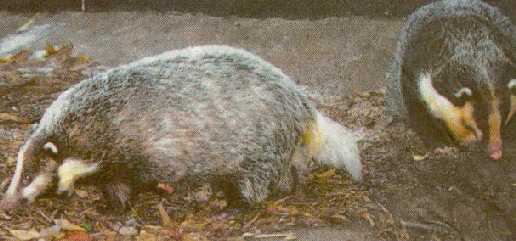 Hog
Badger - These little rascals are
finally out on display along the Leopard Trail since 18 August 2002 but they are
still undergoing conditioning. On the first night, 2 of the hog badgers (see
right) wandered
out of their habitat by swimming under the hot wires. One of them was eventually
caught later that night while the other, believed to be a female (the one
pictured in the far right, LOL ! ), remained at
large till today. She is suspected to be hiding somewhere near to the Golden
Cats' habitat where there is an abundance of worms for her to feed on. The
full-time rangers hope to recapture her soon with a trap and fortunately for
everyone, she is not a dangerous animal, phew ! If anyone has seen her or
has any info on her whereabouts, please inform the full-time Rangers (as if she
is a criminal ! ).
Hog
Badger - These little rascals are
finally out on display along the Leopard Trail since 18 August 2002 but they are
still undergoing conditioning. On the first night, 2 of the hog badgers (see
right) wandered
out of their habitat by swimming under the hot wires. One of them was eventually
caught later that night while the other, believed to be a female (the one
pictured in the far right, LOL ! ), remained at
large till today. She is suspected to be hiding somewhere near to the Golden
Cats' habitat where there is an abundance of worms for her to feed on. The
full-time rangers hope to recapture her soon with a trap and fortunately for
everyone, she is not a dangerous animal, phew ! If anyone has seen her or
has any info on her whereabouts, please inform the full-time Rangers (as if she
is a criminal ! ).
From
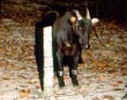 Anoa - A
'victim' of change and some say low work performance level, the Anoa was one
indeed one of the hardest animal to spot (other than the Giant Anteater) both
along the tram route and walking trail over the past few years. On the occasions
that it could be seen, it brought about a mixture of reactions from guests. Some
claimed that it is a goat until they read the sign board or were informed by the
tram guides that it is actually the smallest buffalo in the world. Hence it is
also called the Dwarf Buffalo. So rare is this solitary animal that it
currently lives only on the Indonesian island of Sulawesi.
Anoa - A
'victim' of change and some say low work performance level, the Anoa was one
indeed one of the hardest animal to spot (other than the Giant Anteater) both
along the tram route and walking trail over the past few years. On the occasions
that it could be seen, it brought about a mixture of reactions from guests. Some
claimed that it is a goat until they read the sign board or were informed by the
tram guides that it is actually the smallest buffalo in the world. Hence it is
also called the Dwarf Buffalo. So rare is this solitary animal that it
currently lives only on the Indonesian island of Sulawesi.
To
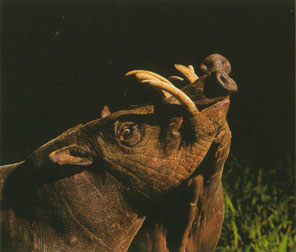 For the time being,
Since 2002, the Anoa's prime location is being occupied by the seemingly uninteresting
fellow islanders - the Babirusas.
We have more than enough of these wild pigs. Although the Babirusas are just as
rare as the Anoa, we have no lack of them as evident by their overwhelming
presence along another part of the tram route (Indo-Malayan region near the
Malayan Tigers) and Forest Giants Trail. Perhaps just like typical pigs,
Babirusas simply breed too well. Wish the tigers would gobble up a few !
For the time being,
Since 2002, the Anoa's prime location is being occupied by the seemingly uninteresting
fellow islanders - the Babirusas.
We have more than enough of these wild pigs. Although the Babirusas are just as
rare as the Anoa, we have no lack of them as evident by their overwhelming
presence along another part of the tram route (Indo-Malayan region near the
Malayan Tigers) and Forest Giants Trail. Perhaps just like typical pigs,
Babirusas simply breed too well. Wish the tigers would gobble up a few !
Migration
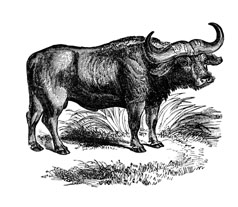 Cape
Buffalo - They had lived
in the open savannahs for many years and Night Safari's captive breeding
program of these great beasts was so successful that 2 pairs were sent back to
South Africa to repopulate the disease-depleted local population. But then due
to Night Safari's constant need to provide guests with greater animal variety,
they had plans to send the remaining Cape Buffaloes to other zoos while their habitat here was painstakingly prepared for some larger and more exciting animals that also
hail from Africa, the Nile
Hippopotamus! So look out
for these new mega-herbivores who have just moved in (early June 2002) along the African region of the tram route and walking trail !
Cape
Buffalo - They had lived
in the open savannahs for many years and Night Safari's captive breeding
program of these great beasts was so successful that 2 pairs were sent back to
South Africa to repopulate the disease-depleted local population. But then due
to Night Safari's constant need to provide guests with greater animal variety,
they had plans to send the remaining Cape Buffaloes to other zoos while their habitat here was painstakingly prepared for some larger and more exciting animals that also
hail from Africa, the Nile
Hippopotamus! So look out
for these new mega-herbivores who have just moved in (early June 2002) along the African region of the tram route and walking trail !
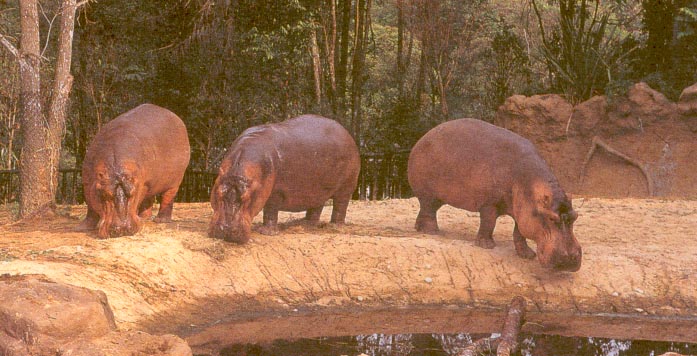
Latest news
dated Dec 2002 -
The Cape Buffaloes have returned to their former habitat along the tram
route since Dec 2002. Most of the adult buffaloes from the former herd have been
sent to South Africa. A younger herd of Cape Buffaloes are now on display in that habitat just across the road from the
1st Bongos' habitat,
the one near the new wooden bridge.
Moved Home
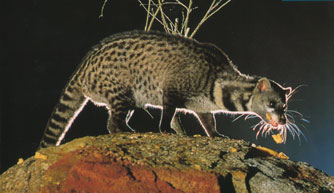 The
Malay
Civets have
just moved (Sep 2003) into the pythons' former habitat. Their new co-tenants are
the Small-toothed
/ Three-striped Palm Civets
who have been away from the limelight for a long time. The ex-pythons' habitat
seems perfect for the Small-toothed Palm Civets, with sufficient
inter-connecting branches for them to climb and play with. We are not too sure
how the Malay Civets find the terrestrial section of the habitat. After being
used to having a whole space for themselves, it might not be easy to adapt and
to learn to share a territory. Hopefully the 2 species of civets can sort it out
between themselves :-)
The
Malay
Civets have
just moved (Sep 2003) into the pythons' former habitat. Their new co-tenants are
the Small-toothed
/ Three-striped Palm Civets
who have been away from the limelight for a long time. The ex-pythons' habitat
seems perfect for the Small-toothed Palm Civets, with sufficient
inter-connecting branches for them to climb and play with. We are not too sure
how the Malay Civets find the terrestrial section of the habitat. After being
used to having a whole space for themselves, it might not be easy to adapt and
to learn to share a territory. Hopefully the 2 species of civets can sort it out
between themselves :-)
The Long-tailed
Porcupines are now
the new residents that are occupying the Malay Civets' ex-territory. These
animals have not been seen for as long time as the Small-toothed Civets. The
Long-tailed Porcupine used to live together with the previous Eagle Owl at the
former Owl habitat (some time in 1999). Back then, there was only 1 such
porcupine on display and it was hardly seen. There was also no sign to indicate
its presence and the VRs of those early days seldom pointed out the porcupine to
guests. Now that there are a few of them in this new habitat, they are much
easier to spot and view. Do drop by and visit them if you can and see how
different these porcupines are, when compared with the regular spiky ones that
we are so familiar with!
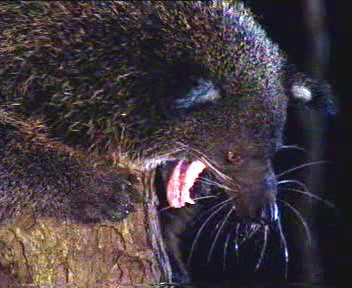 Binturong -
Like
humans, the Binturongs were also greatly affected by the recent economic
recession. In 2001, they had no choice but to pack up and leave their larger
and posh home along the Fishing Cat Trail and make do with a smaller and shared
habitat with the Otters along the Leopard Trail. Since moving in, the Binturongs
have to confine themselves to the trees as the Otters had made it clear with
their chisel-sharp teeth and greater numbers that the Binturongs are not allowed
near their exclusive Otters' Creek. Talk about tough times!
Binturong -
Like
humans, the Binturongs were also greatly affected by the recent economic
recession. In 2001, they had no choice but to pack up and leave their larger
and posh home along the Fishing Cat Trail and make do with a smaller and shared
habitat with the Otters along the Leopard Trail. Since moving in, the Binturongs
have to confine themselves to the trees as the Otters had made it clear with
their chisel-sharp teeth and greater numbers that the Binturongs are not allowed
near their exclusive Otters' Creek. Talk about tough times!
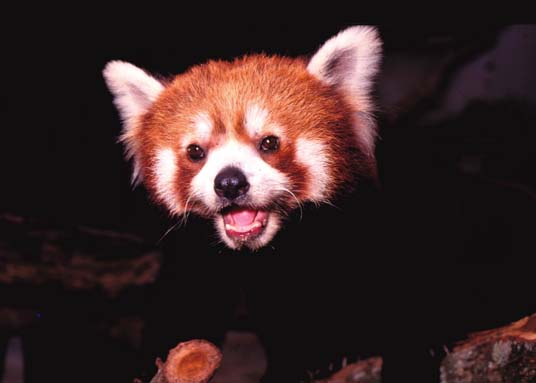 Meanwhile, the
Binturong's ex-home was allocated to the very highly endangered Red
Pandas. Due to their
thick fur, they are provided with their very own air-conditioned room! 2 Red
Pandas currently share the habitat and they take turns to come out for about 2
hours each night before retreating back into the comforts of their cosy suite!
If the Binturongs had a say, they would claim that they definitely cost
less for Night Safari to maintain if they had stayed put at their old home!
Meanwhile, the
Binturong's ex-home was allocated to the very highly endangered Red
Pandas. Due to their
thick fur, they are provided with their very own air-conditioned room! 2 Red
Pandas currently share the habitat and they take turns to come out for about 2
hours each night before retreating back into the comforts of their cosy suite!
If the Binturongs had a say, they would claim that they definitely cost
less for Night Safari to maintain if they had stayed put at their old home!
Martyrs
Last but not least,
this section is dedicated to those very loyal animals that fulfilled their
duties at Night Safari till the very end of their short lives. With no
complaints, they worked hard every night in their bid to give the guests a truly
unique experience in the wilderness. The following animals may be small, easily
forgotten and their absence hardly noticed, but they will forever live in the
hearts of the many individuals who love and remember them.
Egyptian Fruit
Bat - These little
terrors of the Mangrove Walk were affectionately known as the 'flying hamsters'
simply because if you looked closely at them, they had the exact face, body and
even size of hamsters (not counting the wings of course!). The little rascals
got a kick out of inducing screams in the Mangrove Walk as they swooped closely
above the heads and past the ears of 'intruding' guests. On colder rainy nights,
they would hang and huddle closely together in a group of 6-8 bats on a single
branch (at eye level) for warmth.
Then gradually, the
bats reduced their 'games' as their friends and family members fell prey to a
mysterious predator that stalked them day and night. They put their faith in the
humans to save them from this unknown peril but alas, their hopes and prayers
were all in vain. Despite their heightened alertness, the helpless little bats
eventually succumbed to fatigue and lost of faith (late 2000). Till today, the
murderer (suspected to be a wild python) is still at large and the case remains
unsolved.
 Golden
Agouti
- This South
American rodent was slightly bigger than a rabbit and from afar, it resembled a miniature
Capybara. The Agouti shared the same habitat with the lonely Giant Anteater who
lost his spouse many years back. The Agoutis were good-natured co-tenants who
would were contented with just sitting idly around in the open. But the Giant
Anteater sometimes used its long snout to 'smack' the sitting Agoutis out of its
way as the tram passed by, as if saying, "Hey I'm the star here and not you, so
get lost!" LOL !
Golden
Agouti
- This South
American rodent was slightly bigger than a rabbit and from afar, it resembled a miniature
Capybara. The Agouti shared the same habitat with the lonely Giant Anteater who
lost his spouse many years back. The Agoutis were good-natured co-tenants who
would were contented with just sitting idly around in the open. But the Giant
Anteater sometimes used its long snout to 'smack' the sitting Agoutis out of its
way as the tram passed by, as if saying, "Hey I'm the star here and not you, so
get lost!" LOL !
Then one day, the
sky darkened for the Agoutis as wild hawks appeared from nowhere and scooped up
the little rodents off the ground like candies. Day by day, the rodents lived
helplessly in constant fear until the very last Agouti disappeared some time in
the middle of 2001, sniff !
Retired
Animals on at the
Entrance
|

|
Animal Name: Hoffman’s
Two-Toed Sloth
(retired in Mar 2005)
Scientific Name:
Choloepus
hoffmanni
Range: Northern
region of South America
Habitat: Amazon
Forest
Diet: Leaves,
shoots and fruit.
Social structure:
Solitary
Life Span:
Wild - 20 years, Captivity - 31 years.
Conservation/status: At
risk from loss of habitat due to deforestation. Also hunted by man for its
meat.
Remarks: There
are 2 claws on the fore limbs and 3 on the hind ones. The sloth spends
most of its life hanging upside down from the forest canopy. It moves only
in slow motion, 1 limb at the time. Algae grow on its fur, aiding in
camouflage. Possessing a multi-chambered stomach, the food takes more than
1 month to reach the intestines. Faeces and urine are passed out only once
a week.
|
|

|
Animal Name:
Kinkajou (retired
in Mar 2005)
Scientific Name: Potos
flavus
Range: Southern
Mexico to Mato Grosso in Brazil
Habitat: Tree
canopy of tropical forests
Diet: Sweet
fruits and plant nectar, raids bee’s nests, plunging paw into hive and
licking off any honey stuck to its palms.
Social structure: Lives
alone, in pairs or in loosely-knit groups.
Life Span:
Wild - 19 years, Captivity - 23 years.
Conservation/status: Not
threatened, but rarely seen in natural habitat so precise status hard to
confirm, most probably affected by deforestation.
Remarks: The
kinkajou one of the 2 carnivores (the other is the Binturong) with a
prehensile tail. It is closely related to
the raccoon.
|
Retired
Animals on the
Fishing Cat Trail
|
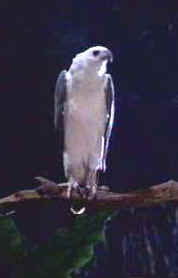
|
Animal
Name: White-bellied Sea Eagle (or
White-breasted Fish Eagle, Sea Eagle) - retired
in Mar 2005
Scientific Name: Haliaeetus
leucogaster
Range: India,
Sri Lanka through southeast Asia, Philippines, New Guinea, Australia and
Tasmania
Habitat: Coastal
regions, terrestrial wetlands, nests in forest, woodlands and rocky cliffs
Diet: Mainly
fish, but will hunt sea birds, reptiles, mammals and roosting fruit bats
which they snatch from trees. They will rob other sea birds of their catch
too.
Social structure: Solitary
Life Span:
Conservation/status: Not
threatened but some have laid thin-shelled eggs due to effects of DDT.
Remarks: Considered
a common bird of prey in the coastal regions of Australia, Asia and even in Singapore.
|
|
|
Animal
Name: Nilgai (or Bluebull)
-
retired in
Oct/Nov 2001
Scientific Name: Boselaphus tragocamelus
Range: India
Habitat: Grasslands
and woodlands.
Diet: Leaves, buds, grasses, fruit.
Social structure: Live
in single sex or mixed herds of 4-20 individuals, old bulls may be solitary.
Life Span:
Conservation/status: Classified as a low risk, conservation dependent species by the IUCN (1996).
Remarks: The largest of the Asian/Indian
antelope. Nilgai is a Hindi name for 'blue
cow'. This antelope is also known as the Bluebull in English. The adult males are bluish grey in color and the females
are brown. Considered a very sacred animal and protected
in parts of India for religious reasons. A major prey of Asian Lions.
|
|
Animal
Name: Indian Blackbuck -
retired in
Oct/Nov 2001
Scientific Name: Antilope
cervicapra
Range:
India
Habitat:
Grasslands
Diet:
Grass
Social structure:
Live in herds.
Life Span:
Up to 18 years.
Conservation/status:
A rare animal in India due to hunting by trophy
hunters.
Remarks:
Only male blackbucks are black, the females are
brown. Males have beautiful 1m long spiral horns used to attract females
and fight other males. The spirals horns are highly desired by trophy
hunters. Blackbucks are also considered sacred animals in some parts of India.
|
Retired Animals on the
Leopard Trail
|

|
Animal Name: Jungle
Cat - replaced by hog badger in Aug
2002
Scientific Name: Felis
chaus
Range: From
Egypt to Sri Lanka and Indochina
Habitat: Woodlands
or open country:
Diet: Small
mammals, reptiles, snakes, frogs, birds
Social structure: Solitary
Life Span:
Wild - 10 to 15 years
Conservation/status: Not
threatened
Remarks: The
young are born with spots and stripes which disappear upon reaching
maturity. Jungle cats live and raise their young in the abandoned
burrows of other animals.
|
|
|
Animal Name:
Firefly
- habitat closed and
fireflies released in Feb 2004 Scientific Name: -
Range: Warm
humid regions of tropical Asia, and Central and South America.
Habitat: Ponds,
streams, marshes and mangroves.
Diet: The
larvae eat earthworms, snails and slugs. The adults either feed on plant
nectar and pollen or do not eat at all.
Social structure: Larvae
are solitary, adults congregate to mate after emerging from the pupae.
Life Span:
3 - 4 months, some species up to 6 months
Conservation/status:
Habitat loss is a
serious threat for many species.
Remarks: Both
sexes flash their lights to attract each other. Fireflies have a
chemical called luciferin near their rear ends. They breathe in oxygen
that reacts with luciferin to produce the distinctive flashlights. 100%
of this energy produced is light, unlike the light bulb where only 10%
is light and the remaining 90% is wasted as heat.
|
|
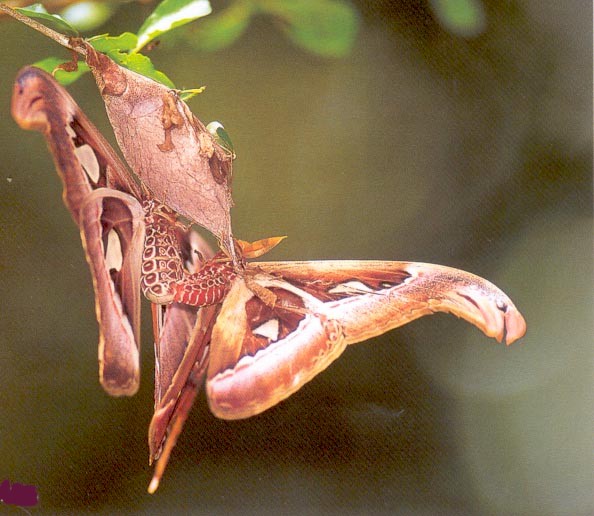
|
Animal Name:
Atlas Moth
-
retired in Nov
2003
Scientific Name: Attacus
atlas
Range: Warm
humid regions of Southeast
Asia, also common in Singapore.
Habitat: Tropical
jungles
Diet: The
caterpillars eat a variety of plants. The adults have no mouths so
they do not eat. They live off their body fat reserves that were
built up when they were caterpillars.
Social structure: Caterpillars
are solitary, adults congregate to mate after emerging from the pupae.
Life Span:
-
Conservation/status:
Threatened
by deforestation.
Remarks: The
Atlas Moth has the biggest wingspan of all moths. It reaches from
25-30 cm across. In flight, the moth is easily mistaken for a
small bird! In Greek mythology, Atlas was one of the titans, hence this
giant moth takes on this name. The silk of the cocoons are used to make fabric in India and
Taiwan.
|
|
|
Animal Name: Reticulated
Python - replaced by
Malay
Civet and Small-toothed Civet in Sep 2003
Scientific Name:
Python reticulatus
Range:
Southeast
Asia and nearby Pacific islands
Habitat: Rainforests,
woodlands, grasslands.In Singapore, these snakes even live in our sewers
and storm water drains and help control the rodent population.
Diet: Warm-blooded
prey like mammals
and birds
Social structure: Solitary
Life Span:
Over 50 years
Conservation/status:
Threatened
in Singapore, endangered in other parts of its range.
Remarks: Reticulated
patterns on its skin allow it to camouflage easily on the forest floors.
Pythons kill small prey by coiling around them and squeeze them till
their bones are crushed, For larger prey, they coil around their ribcage
(to stop it from rising) and suffocate them. Pythons can dislocate their
lower jaws to swallow prey bigger then their heads. Pythons are the
longest snake in the world, they can grow up to 10m long.
|
Retired Animals on the Tiger
Walkway
|
|
Animal Name: Anoa
- replaced by Babirusa in
2002
Scientific Name: Bubalus
Depressicornis
Range: Confined
to lowland forests of North Sulawesi
Habitat: Swampy
lowlands
Diet: Grass
Social structure: Solitary
or at most in pairs, territorial
Life Span:
Conservation/status: Endangered
Remarks: The
world’s smallest buffalo and its small size helps it to live easily in
dense forests. The short horns point backwards so they do not get caught
in the bushes when the anoa flees through the forests from danger. It
seems to be one of the most dangerous animals to handle in
captivity.
|
 Kinkajou
- These seldom seen
little animals were finally retired since there was not much difference in
displaying them. They had a prime location outside the entrance of Night Safari
where there was no nearby competition from other animals for the attention of
the guests. But the kinkajous did not make full use of the opportunity given to
them so out they went. Heard that the group used to consist of a family and
young. Later it became a male and female pair who would often be seen mating in
public! What an amorous couple, LOL !
Kinkajou
- These seldom seen
little animals were finally retired since there was not much difference in
displaying them. They had a prime location outside the entrance of Night Safari
where there was no nearby competition from other animals for the attention of
the guests. But the kinkajous did not make full use of the opportunity given to
them so out they went. Heard that the group used to consist of a family and
young. Later it became a male and female pair who would often be seen mating in
public! What an amorous couple, LOL !


 For the time being,
Since 2002, the Anoa's prime location is being occupied by the seemingly uninteresting
fellow islanders - the
For the time being,
Since 2002, the Anoa's prime location is being occupied by the seemingly uninteresting
fellow islanders - the  Cape
Buffalo - They had lived
in the open savannahs for many years and Night Safari's captive breeding
program of these great beasts was so successful that 2 pairs were sent back to
South Africa to repopulate the disease-depleted local population. But then due
to Night Safari's constant need to provide guests with greater animal variety,
they had plans to send the remaining Cape Buffaloes to other zoos while their habitat here was painstakingly prepared for some larger and more exciting animals that also
hail from Africa, the Nile
Hippopotamus! So look out
for these new mega-herbivores who have just moved in (early June 2002) along the African region of the tram route and walking trail !
Cape
Buffalo - They had lived
in the open savannahs for many years and Night Safari's captive breeding
program of these great beasts was so successful that 2 pairs were sent back to
South Africa to repopulate the disease-depleted local population. But then due
to Night Safari's constant need to provide guests with greater animal variety,
they had plans to send the remaining Cape Buffaloes to other zoos while their habitat here was painstakingly prepared for some larger and more exciting animals that also
hail from Africa, the Nile
Hippopotamus! So look out
for these new mega-herbivores who have just moved in (early June 2002) along the African region of the tram route and walking trail ! The
The

 Meanwhile, the
Binturong's ex-home was allocated to the very highly endangered
Meanwhile, the
Binturong's ex-home was allocated to the very highly endangered  Golden
Agouti
- This South
American rodent was slightly bigger than a rabbit and from afar, it resembled a miniature
Capybara. The Agouti shared the same habitat with the lonely Giant Anteater who
lost his spouse many years back. The Agoutis were good-natured co-tenants who
would were contented with just sitting idly around in the open. But the Giant
Anteater sometimes used its long snout to 'smack' the sitting Agoutis out of its
way as the tram passed by, as if saying, "Hey I'm the star here and not you, so
get lost!" LOL !
Golden
Agouti
- This South
American rodent was slightly bigger than a rabbit and from afar, it resembled a miniature
Capybara. The Agouti shared the same habitat with the lonely Giant Anteater who
lost his spouse many years back. The Agoutis were good-natured co-tenants who
would were contented with just sitting idly around in the open. But the Giant
Anteater sometimes used its long snout to 'smack' the sitting Agoutis out of its
way as the tram passed by, as if saying, "Hey I'm the star here and not you, so
get lost!" LOL ! 